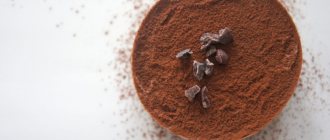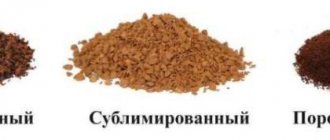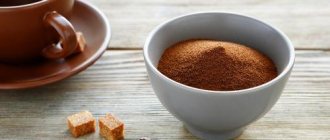When you go to the store for coffee, sometimes you get lost among the variety of bright packaging, colorful cans and boxes. If when buying natural coffee you can somehow navigate by the type or country of origin of the beans, then instant coffee differs, at first glance, only in cost and name. We present our own ranking of instant coffee, which will help you navigate the abundance of manufacturers.
In most ratings that can be found on the Internet, it is completely impossible to understand on what basis the authors make their lists and tables. Therefore, before starting work on this material, we tried to determine the main criteria for the top list.
The main things for us, ordinary consumers, are taste, smell and price. Quality can be determined by its appearance and solubility. For evaluation, we chose popular freeze-dried coffee. Neat granules without small inclusions, rapid solubility that does not form sediment are signs of a worthy product.
History of instant coffee
Coffee as a natural energy drink is good for everyone, except for one thing: it is too difficult to prepare in the field. Therefore, already in the 18th century, the idea arose of creating a coffee concentrate that did not require long brewing in a Turk. The first instant coffee, called Blend Coffee, was created in 1771 in Britain.
Its taste and aroma were much worse than that of natural coffee, but the War Ministry purchased the “Coffee Blend” for the needs of the army. Until our time, almost all major improvements in the technology for producing instant coffee occurred either at the request of military departments or during wars.
Instant coffee appeared in the USA in 1853. It was not cheap, since the raw material was expensive Arabica, and the taste and smell left much to be desired. The concentrate was not in demand until 1861, when the Civil War broke out in the country. Instant coffee bars, called “cakes,” were included in the rations of Northern soldiers.
In the second half of the 19th century, scientists from different countries worked on the creation of high-quality instant coffee. Variants of the powder manufacturing technology were patented: in 1881 by the Frenchman Alphonse Alleys, in 1890 by the New Zealander David Strang, in 1901 by the American Satori Kato. The concentrate was advertised as coffee for travelers, but people were reluctant to buy it.
George Constant Louis Washington, a Belgian scientist who lived in Guatemala for a long time, developed his own method for producing instant coffee. He moved to the USA and, despite the fact that many experts spoke negatively about the taste of the drink, he founded the company in 1909 and began producing Red E Coffee.
Instant coffee and world wars
If in peacetime consumers preferred more aromatic and refined natural coffee, then for soldiers the most important thing was the simplicity and speed of preparing the drink. The popularity of the concentrate was also facilitated by the fact that, starting in 1913, the US government banned the use of alcohol in the navy.
When the country entered World War I in 1917, instant coffee became a real salvation for soldiers. People who were accustomed to morning coffee were plagued by headaches due to a lack of caffeine. But it was simply impossible to brew natural coffee in the field kitchens, since the aromatic steam gave away the location of the positions to the enemy, and the Germans could use the poisonous mustard gas at any time. The American military had to strengthen their strength with a concentrate dissolved in hot water.
In honor of the most famous manufacturer of instant coffee, soldiers' tin mugs began to be called “Joe mugs”, and the creator himself was called “the soldier’s friend.” By the fall of 1918, the U.S. War Department was ordering 37,000 pounds (14.8 tons) of instant coffee daily, although as recently as 1916 all U.S. companies were producing only 6,000 pounds (2.4 tons) of concentrate per day.
When the war ended, Washington's company flooded the United States with leaflets featuring a military-clad coffee can. The inscription read: “Went to war. Home again." The soldiers, accustomed to instant coffee, returned home and accustomed their families to it.
Instant coffee returned from the war with the soldiers
Until 1938, George Washington's company dominated the international instant coffee market. But in the 30s of the 20th century, a crisis of overproduction broke out in Brazil: huge reserves of robusta could not be sold, and coffee prices collapsed.
The Brazilian government turned to the management of the Swiss company Nestle with a request to help process the robusta that had accumulated in warehouses. Scientist Max Morgenthaler created a technology for evaporating coffee extract with hot air, which made it possible to obtain coffee of much better quality than other samples on the market. Since that time, the profits of the George Washington company began to decrease, in 1943 it was sold, and in 1961 it stopped producing instant coffee.
In Nestle coffee, instant coffee was called Nescafе, carbohydrates were added to the composition for better solubility than the Red E Coffee familiar to Americans. In Switzerland, the first sales of Nescafé took place on April 1, 1938. The concentrate was such a success that the company began building a plant in London. But the main customer of the new drink was the US War Department. During World War II, it purchased about a million cases of Nescafe.
Creator of Nescafe instant coffee, chemist Max Morgenthaler at work
Although the supplier of the concentrate was different, the US military still called both instant coffee and natural coffee prepared in a filter coffee maker “Mug of Joe.” By demanding that this coffee be prepared for them, the American soldiers drove the Italian baristas into hysterics until they realized to dilute the strong espresso with water. This is how the Americano coffee recipe came about.
Discovery of the sublimation process
Scientists at the National Research Corporation (NRC), located in Massachusetts, commissioned by the military department during World War II, worked on the development of high-vacuum technologies (for producing penicillin, streptomycin, and blood plasma). It turns out that the same principle applies to instant coffee. Moreover, the concentrate frozen in a vacuum turned out to be an order of magnitude better than that dried with hot air.
The composition of instant coffee has also improved: starting in 1954, Nescafe, and then the products of other brands, stopped stabilizing them with carbohydrates. By the 1980s, up to 40% of instant coffee from well-known brands was produced using the sublimation method.
In the 21st century, the time has come for new technologies. The legendary Don Valencia, who headed the scientific research department of Starbuks, created freeze-dried coffee that tastes as close as possible to natural coffee. Now this coffee, called Via, is added to all Pepsi coffee drinks.
Is there a benefit?
In addition to the question of whether instant coffee is harmful to health, it is logical to try to find at least some benefit in it. Yes, there are some benefits to drinking this drink, although some believe this is a controversial issue. The first thing people talk about is the good mood and vigor that a cup of coffee gives in the morning. But here it’s less about the taste of the drink and more about its aroma, which tickles the nostrils and penetrates the brain. Psychology also plays a big role. Many coffee lovers have turned “drinking” this drink into a ritual. It’s hard to break a habit because it gives you pleasure. Such a vicious circle.
The low calorie content of a cup of coffee allows it to be included in many types of diets. And if you add milk there, some benefits will appear. But at the same time, this product can disrupt proper metabolism, which does not contribute to weight loss at all. And often after coffee you want to eat - it increases your appetite.
Technologies for the production of instant coffee
Today, about 50% of green coffee beans are processed into instant coffee. To make it, manufacturers buy the cheapest beans: robusta and low-grade Arabica.
Based on its composition, instant coffee is divided into:
- made from 100% robusta;
- made from a mixture of Arabica and Robusta;
- containing 100% Arabica.
The beans are medium roasted (mostly American). Roasted beans should not be ground immediately, otherwise they will begin to explode. Within 3–4 hours after roasting, the coffee “rests,” releasing aromatic substances and volatile products formed when organic matter is heated. Then the grains are ground. The grains must be at least 0.5–1.1 mm in diameter, otherwise due to the high temperature they will begin to burn, giving the concentrate a burnt cork smell.
A stream of water at a temperature of +140 to +180 °C is applied to the ground grains placed in columns under high pressure. As a result, carbohydrates are washed out of coffee. When the water cools to +100 °C, aromatic substances dissolve in it. The process takes several hours. The liquid is then cooled to +40 °C. At the end of the cycle, a coffee extract containing 20–30% solids is obtained.
It is filtered and thickened using one of three methods:
- separate the water using a centrifuge;
- evaporate;
- frozen and mechanically separated the frozen water crystals from the coffee extract crystals.
The resulting thick coffee extract contains up to 40% solids, but is almost completely devoid of volatile aromatic compounds. To later impart aroma to instant coffee, manufacturers collect essential oils. This is one of the most difficult processes, since the slightest violation of technology leads to the fact that the powder acquires a musty smell.
Each manufacturer has its own secrets. Some collect aromatic substances that evaporate after roasting. Others moisten the ground coffee and heat it under reduced pressure, which releases the aromatic components. Sometimes warm nitrogen is passed through a layer of moistened ground coffee and the gas is vented into a cryochamber where the aromatic compounds are separated.
There are 2 technologies for producing instant coffee:
- spray dry - hot drying. The extract is sprayed under a stream of hot air. As a result, the moisture evaporates and powdered instant coffee is formed. If you need to make it granular, the powder is additionally treated with steam;
- freeze-dried – freeze-drying (a method for producing freeze-dried coffee). The coffee extract is pre-cooled to a temperature of –6 °C. Then it is applied in a thin layer to a drum, steel belt or pallet and frozen to a temperature of – 40 °C. If freezing occurs quickly, within 0.5–4 minutes, small light crystals are obtained. Slow freezing (10–180 minutes) produces large dark granules. Ice slabs are broken, ground and sifted. Small particles are sent for re-freezing. Large pieces of ice are placed in a vacuum chamber, where the water instantly expands. It is removed using convection.
At the last stage, instant coffee is flavored. Natural essential oils extracted from grains are added to expensive varieties, while artificial flavors are added to cheap varieties.
Instant coffee without caffeine is available on sale. It is obtained by passing green coffee bean extract through a carbon filter, which retains caffeine molecules. The cost (and therefore the price) of such coffee is more expensive than regular coffee.
How this instant drink can affect acidity
Perhaps the most powerful harmful effect that occurs with constant consumption of instant granulated coffee. Increased acidity in the stomach and intestines is caused by numerous dyes included in any instant coffee. Manufacturers of this instant drink often skimp on natural ingredients. As a result of systematic abuse, the risk of diseases of the gastrointestinal tract increases and the functioning of gastric juice enzymes is disrupted. Increased stomach acidity is the first harbinger of gastric ulcers and other digestive system disorders. You can reduce this harmful effect by simply stopping drinking instant coffee on an empty stomach.
How to choose instant coffee
In order not to make a mistake in choosing instant coffee, you should adhere to the following rules:
- in the store you need to meticulously examine the label: the name and design must be clear, the barcode must correspond to the country of origin;
the best instant coffee is freeze-dried, although powdered and granulated coffee can also have a pleasant taste;
- Arabica coffee tastes better than robusta coffee, but Arabica coffee has less caffeine;
- If you can smell bread notes in the coffee aroma, it means roasted barley has been added to the concentrate. It’s better not to buy this kind of coffee;
- the smell of burnt cork means that the manufacturer overcooked the beans or violated the technology when making the extract. Unfortunately, this and the previous flaw can only be discovered after purchase. But it makes sense to remember the manufacturer and not buy its products again;
- a good concentrate should be completely dissolved in water or milk.
Granulated (agglomerated) coffee
Granulated coffee is no longer powder, but coffee knocked into small lumps. To obtain it, ready-made coffee powder is again moistened and knocked into granules using steam. Under the influence of strong pressure, the molecular structure of the grain changes: the solubility of such coffee increases, its color becomes more saturated, but the aroma and taste deteriorate.
Due to its greater solubility, granulated coffee is gradually replacing powdered coffee. The most famous brands of granulated coffee are “Nescafe Classic”, “Maxwell House”, “Jacobe Maxima”, “Folgers Extra Mocha”. “Mocha na ekseplent”, “Grandos classic”.
How to brew instant coffee
Its taste largely depends on the technology for preparing instant coffee. The concentrate is never poured with water heated above +90 °C. At higher temperatures, chemical flavors and other additives begin to decompose and give the coffee an unpleasant taste.
Instructions
- Warm a cup with boiling water.
- Pour instant coffee and sugar into the bottom and stir.
- Splash some hot water.
- Mix the contents of the cup thoroughly until the coffee and sugar are completely dissolved.
- Add the rest of the water.
When contacting some types of instant coffee, milk curdles. To avoid this, the concentrate is always first dissolved in a small amount of water and then milk or cream is added.
To give the drink a pleasant taste, before adding water, the concentrate can be mixed with a pinch of cinnamon, cocoa, cardamom, or anise. Latte, ice, cappuccino and other milk-coffee cocktails are prepared from instant coffee.
To take or not to take
After studying the types of instant coffee, a logical question arises: which type is better?
Due to the method of its manufacture, freeze-dried food retains its original qualities and beneficial properties better than others. However, the cost of its production is much higher, which makes this type more expensive than others.
But what option is definitely not worth taking (except perhaps only occasionally for the sake of pampering) is 3 in 1 coffee. In this case, the anger of true coffee lovers is righteous - this product will really do more harm than good: 10 grams per package. contains approximately 2-3 grams. coffee, and the rest is sugar and milk mixture. Thus, after drinking just a cup, you will receive a shock dose of sugar and no energy, except for a short-term excitement from an increase in insulin levels.
The benefits and harms of instant coffee
Instant coffee contains caffeine, so it affects the body in much the same way as natural coffee: it invigorates, promotes concentration, and has a diuretic effect. It is difficult to judge which coffee has more caffeine: its content in the soluble concentrate depends on the manufacturer. One 250 ml cup of instant coffee can contain from 30 to 200 mg of caffeine.
The alarming thing is that with prolonged heating, the carcinogen acrylamide is formed in the concentrate (this compound is also found in chips and some other products). Scientists say that excessive consumption of instant coffee leads to the formation of kidney stones.
Although experts argue about the benefits and harms of instant coffee, it is not recommended to drink it if you have diseases of the liver, gallbladder and pancreas. The drink contributes to dehydration of the body, which causes premature aging and darkening of the facial skin. Therefore, you should not drink more than 1-2 cups of instant coffee per day.
Are there any benefits to coffee?
Despite the many disadvantages of instant coffee, its use is only growing every year. The secret lies in the advantages of the product:
- easy and quick to prepare;
- long shelf life;
- smells nice.
Are these advantages so significant that drinking a drink could endanger your health? The answer to the question is ambiguous.
Taster's choice
The slightly immodest name “Gourmet’s Choice” is fully justified upon first acquaintance. For the convenience of customers, the Korean company has divided its products by strength. The strongest coffee, close to ground coffee, is sold in red packaging. The yellow can or packet contains granules with a medium caffeine content. Under the green label, decaffeinated “soft” awaits the gourmet. The average price for 100 g is 300 rubles.
- This is interesting: How to get decaffeinated coffee
The good processing of this high-quality instant coffee is indicated by the color and integrity of the granules and the absence of scree. And noble raw materials are expressed in the exceptional characteristics of the drink. This is a real, rich espresso with a slight bitterish-sour aftertaste.
In stores you can find Taster's Choice of American origin. If you believe the reviews, it can't be compared to the Korean original!
Effect on the deterioration of the nervous system
Exceeding the norm by 100-200 milliliters daily has a negative effect on the central nervous system. This process is associated with the accumulation of caffeine in the body, which is a source of irritation for the nervous system. If we also take into account the depression of the mental state caused by caffeine addiction, the effect on the nerves increases by 2-3 times. Reducing the concentration of caffeine in the body will help reduce nervous irritation from the excessive influence of instant coffee. It is worth diluting coffee with cream or milk and reducing daily consumption.
Why harmful ingredients cause cellulite in women
Some erroneous practices and diets are based on the consumption of instant coffee. But it’s worth knowing why you shouldn’t abuse this drink. As noted above, it increases acidity, and therefore speeds up the digestion process. However, instead of accelerating metabolism and rapid weight loss, the exact opposite occurs, a decrease in skin tone. When the norm of 350-400 milliliters per day is exceeded, the skin becomes more flabby. If you resort to such a “diet” regularly, then cellulite will join the sagging. If it is difficult to give up coffee, you should drink a glass of water 15-20 minutes before drinking coffee. This will help neutralize its effects on the skin.











